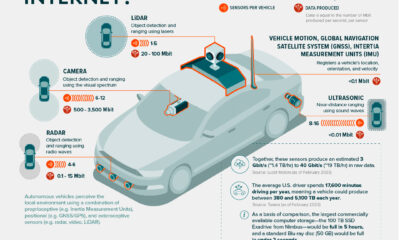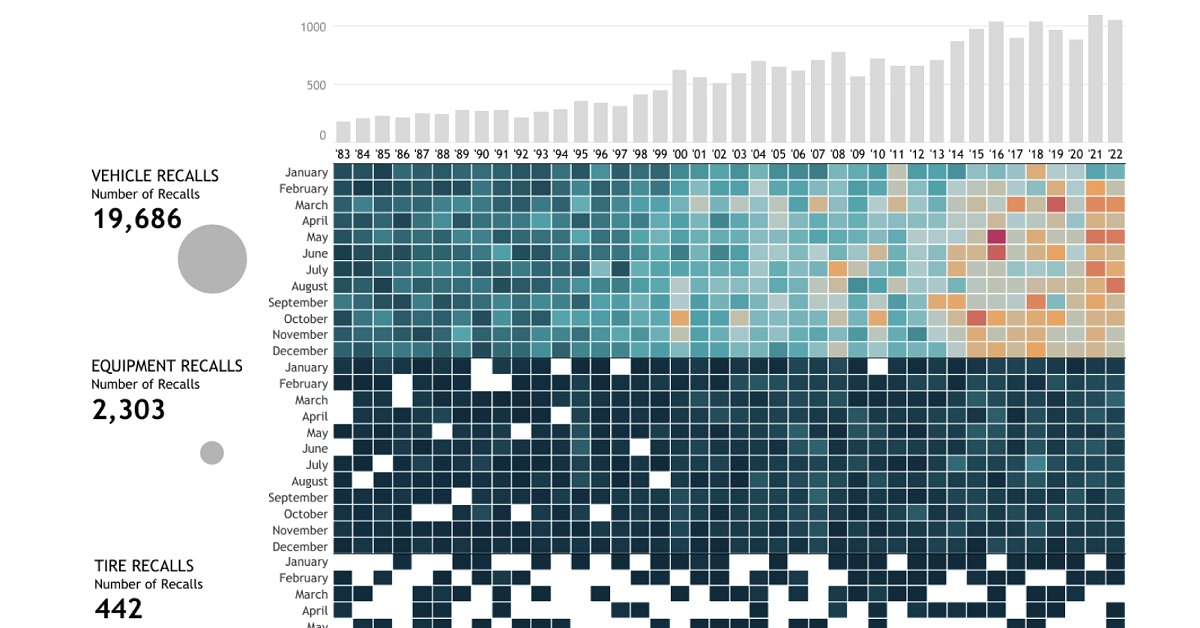Consumers in a dense country might prefer smaller cars, while countries with wide expanses (and parking spots) open the way for larger trucks. Likewise, rugged terrain might call for vehicles that can adapt and scale quickly. And it’s also a question of which manufacturer invested in the country. As the world’s largest automakers have raced to attract consumers in every corner of the globe, they built factories, renamed models, and even built specific cars to fit the tastes of individual countries. This infographic from Budget Direct Car Insurance highlights the best-selling vehicles in the world, using 2019 year-end sales data.
What is the Most Popular Vehicle in Each Country?
Though the map might vary across the board, one thing is certain: Toyota’s dominance. The Japanese automaker—which was also the most valuable automaker in the world for many years before being overtaken by Tesla—had the best-selling vehicle in 41 countries of the 104 countries tallied. It also had the world’s best-selling vehicle in 2019, the Toyota Corolla, though the sedan only took the top spot itself in five countries. As the best-seller in 16 countries, the Toyota Hilux truck (also known as the Toyota Pickup in North America) was the top vehicle in the most countries. It has a noticeably strong market share in the Southern Hemisphere, including in Argentina, South Africa, and Australia. The other consistent factor was the strength of local manufacturers. Many countries with large automakers had local models as the best-selling vehicles, especially in Europe.
Cars are the Best-Selling Vehicles in the World
So what do car consumers currently prefer? Currently, cars have a slight edge over trucks as the best-selling vehicles in the world. Of the 104 countries with sales tallied for the study, smaller cars often classified as “passenger vehicles” (including sedans, hatchbacks, and subcompacts) made up the majority of best-sellers, with 57 of the best-selling vehicles by country. Meanwhile, “light trucks” or “light commercial vehicles,” which include trucks, SUVs, and vans, were best-sellers in 47 countries.
Best-Selling Vehicles by Type
Hatchback: 12 Sedan: 25 Sedan/Wagon: 1 Subcompact: 19 SUV: 20 Truck: 24 Van: 3
But changing car consumption preferences are already making their mark. The electric vehicle (EV) Tesla Model 3 was already the best-selling vehicle in both the Netherlands and Norway, and other countries like China are increasing incentives for consumers to purchase EVs. That’s not even factoring in the slowdown of travel during the COVID pandemic, more workers going remote, and the semiconductor strain on automakers. A truly post-COVID world will likely transform the map even further. on These faulty airbags, installed by 19 different automakers including BMW and Toyota from 2002 to 2015, can explode when deployed and have led to numerous tragic accidents. Their recall affected 67 million airbags (including Honda’s vehicles above) and has been known as the largest safety recall in U.S. history. Over the past four decades, there have been over 22,000 automobile recalls in the United States. In this interactive piece, Chimdi Nwosu uses data from the National Highway Traffic Safety Administration to visualize the types of automobile recalls over the past 40 years, the companies with the most recalls, the components that were recalled the most, and, most importantly, their impacts on people.
Breaking Down U.S. Automobile Recalls
Whether a recall affects specific vehicle components, equipment, or vehicles as a whole, it affects the lives of millions of automobile users. When combined, these numbers ramp up exponentially. The U.S. alone has seen a total of 22,651 recalls over the past 40 years, impacting more than one billion people. Almost 72% of these people were affected by nearly 20,000 vehicle recalls, while around 19% were impacted by over 2,000 equipment recalls during this period. Comparatively, the 442 tire recalls and 220 child seat recalls affected significantly less, but still a total of 96.9 million people. While an inconvenience to many, the recall of these faulty vehicle parts saves many more from unfortunate incidents that may have occurred if left unchecked.
Minor and Major Recalls
One of the largest recalls in history took place in 2014 when General Motors—the manufacturer with the highest total of recalls in four decades—recalled millions of vehicles including the 2005-2007 Chevrolet Cobalt, 2007 Pontiac G5, and 2006-2007 Chevrolet HHR, amongst others. The reason for this recall was a faulty ignition switch that caused the vehicle’s engine to shut down while driving, disabling safety systems including airbags. This fault led to the death of hundreds of people. However, not all recalls are this severe. BMW, for example, recalled just four vehicles in December last year because one of the four bolts in the driver’s backrest was not attached properly. Similarly in 2020, Ford recalled some of its vehicles due to a faulty door latch. While this recall inconvenienced over two million users, it was less likely to lead to severe consequences if left unchecked.
A Safer Future?
The number of automobile recalls over the past four decades has seen a steep rise. As have car safety standards. While recalls could hint at the risks involved in taking your car out for a drive, they also indicate manufacturers taking responsibility for their faulty commodities, and affect a very small percentage of vehicles on the road. To improve automobile safety, the NHTSA proposed a New Car Assessment Program in 2022, which provides vehicle users with safety ratings for every new vehicle. This five-star safety rating program rates the vehicles’ safety features, crashworthiness, and resistance to rollover. With self-driving cars now also entering the mix, we need to stay informed about vehicle safety to keep our vehicles, our streets, and ourselves safe in the future.













